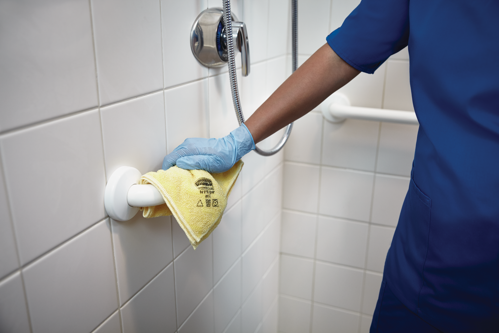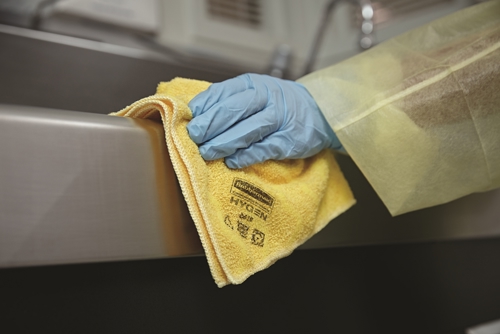
People often have many questions surrounding the proper use of bleach and bleach-safe products to use while disinfecting, sanitising and cleaning, in general. There are many factors to consider when using bleach products, namely pertaining to safety and effectiveness. As with any cleaning product, there are certain instructions that need to be followed to effectively employ the cleaning solution while keeping the safety of others in mind (such as using water to create diluted bleach and utilising certain safety precautions while disinfecting).
As long as precautionary measures are considered throughout the process, chlorine bleach cleaning can be one of the most effective ways to rid a space of germs, bacteria and common viruses like influenza or COVID-19, as explained by the Department of Health.
Better understanding when you can use bleach for cleaning purposes, how to dilute bleach with water and some of the safety tips and benefits that follow bleach cleaning can ensure your commercial property lives up to the highest quality standards. Read on to learn more about the bleach-cleaning process:
When can I clean with bleach?
Bleach is a strong and useful disinfectant in many different instances thanks to its active ingredient, sodium hypochlorite. It makes microorganism proteins break down, thus killing bacteria, fungus and common viruses.
Chlorine bleach can be used for a variety of reasons when it comes to cleaning. It is considered a whitening agent for laundry and used in the washing machine, or on bathroom and kitchen surfaces. But remember: Household bleach can be different from commercial chlorine bleach. Concentration levels are generally the differentiator in this sense; you wouldn’t use the same bleach in the washing machine to take care of your laundry that you would use as a cleaner in a care facility or large commercial organisation.
Bleach can also be utilised to remove mold, and it can be used as a general disinfectant when diluted with water; because the solution is so strong, diluted bleach with water is not a less effective option. It is always advised to dilute chlorine bleach for cleaning purposes— this prevents a leftover bleach residue from forming on surfaces and causing potential irritation if someone comes in contact with it. The water breaks down the bleach concentration and prevents this from happening.
Before you clean with bleach, be sure to use water to rinse and wipe down the surface you intend to disinfect prior to cleaning with the diluted bleach product. Rubbermaid microfibre wipes can be used throughout this entire process, as they are safe for bleach cleaning.
During the dilution process, be sure to follow a 1:10 solution equation: one part chlorine bleach solution for every nine parts water. Once the mixture has been created and utilised, it takes approximately 10 minutes for the water diluted bleach solution to work its magic and kill any existing bacteria or viruses on the surface. Because you’re using diluted bleach to clean, you don’t have to rinse after the cleaning process.
Benefits of cleaning with bleach
Bleach cleaning comes with a variety of advantages. Here are a few reasons why you should consider cleaning with diluted chlorine bleach over an alternative product, specifically during a pandemic:
The price and convenience
Bleach is relatively inexpensive, widely accessible and is one of the few products on the market that efficiently dissolves biofilm. It’s also widely accessible and its feasibility as a disinfectant with broad-spectrum antimicrobial properties has been demonstrated by widespread existing use. Plus, easy access to water makes it simple and seamless to use properly.
It’s effective against outbreaks
According to the Australian Government National Health and Medical Research Council, there is evidence that suggests chlorine bleach disinfectants with sodium hypochlorite as its active ingredient are effective in controlling norovirus outbreaks.
Bleach can be used with Rubbermaid products
Our bleach-safe products in the Rubbermaid HYGEN™ Microfibre System range provides you with optimal infection prevention. Proven to remove 99.9% of microbes, the range offers both laundry safe (up to 500 washes) and disposable microfibre products which allow for flexibility within your successful cleaning practices. Our disposable microfibre products remove 99.99% of human coronavirus, OC43 and help reduce cross-contamination.
Despite the emergence of new disinfection products and alternative technologies, bleach remains one of the most accessible and commonly used disinfectants on the market.
Bleach cleaning safety tips
Beyond diluting bleach with water in our previously suggested equation, there are various other safety precautions to keep in mind while chlorine bleach cleaning. Here are some of our tried and tested safety tips:
Never clean with undiluted bleach
Bleach is often seen as an intimidating product to use due to its level of toxicity when undiluted. Bleach concentrate is stronger than regular bleach, so be sure to make that distinction before purchasing, diluting and employing.
Wear proper protective gear while bleach cleaning
As bleach is corrosive, you must wear protective gear, such as gloves and eyewear. Bleach can cause irritation to the skin, eyes and other mucous membranes. Also be mindful of your clothing while utilising bleach; one misstep and contact with your clothing could result in a bleach spot left behind or severe color fading.
Purchase safe bleach for cleaning
Remember to always purchase bleach that is registered either by the U.S Environmental Protection Agency or another, equivalent regulatory body within your country, and follow the manufacturer's guidelines when using a sodium hypochlorite solution for bleach cleaning.
Always store bleach in a safe, controlled environment
While children may not be roaming the halls of your facility, it’s still important to keep them in mind when storing bleach products. Bleach can also trigger asthma attacks and other health-related issues, so be sure to store bleach products in a safe, controlled environment that sees little foot traffic on a regular basis.
Check the bleach label before getting started
Remember: Bleach concentrate is stronger than regular bleach. Always check the label for sodium hypochlorite concentration before the dilution process so you can safely start bleach cleaning.
There’s no denying how different the world is today. Hygiene plays a major role in our ability to feel safe in public places, and it’s become just as important as cleanliness. Understanding what types of products will create hygienic space within domestic and commercial environments is essential to the safety and comfort of workers and visitors alike. Chlorine bleach cleaning is one of the safest and most effective ways to clean and it should be strongly considered during and after a pandemic.
With this in mind, we recommend looking into the Rubbermaid HYGEN range of products, which are all 100% safe to use with chlorine bleach. For more information on the laundry microfibre and disposable microfibre systems and how they can be used for bleach cleaning, contact us directly today.